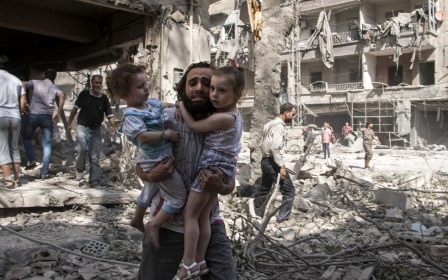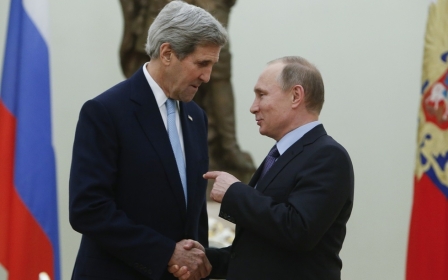Russian air strikes in Syria choking humanitarian aid

ISTANBUL, Turkey – Yakzan Shishakly has been delivering critical aid to Syria for years, overcoming shortages, bombings and the rise of the Islamic State. But since late September, when Russian jets began bombing Syria on a daily basis, Shishakly and his aid group, the Maram Foundation, acknowledge that they have been left facing one of their toughest hurdles yet.
Getting aid into Syria from Turkey is now nearly impossible for Shishakly’s group as well as the region’s largest agencies, who have said that aid delivery has been reduced by 80 percent and that badly needed tents, clothing, food and medical supplies are stockpiling on the Turkish side of the border.
Shishakly and his teams said that the situation for aid groups has become increasingly perilous, with aid convoys now coming under frequent attack from Russian air strikes.
Last week, Shishakly received a frantic call from one of his workers in northwestern Syria who was accompanying two truckloads of tents headed for the Latakia province.
“They had to stop on the road and run away from their trucks, because Russian air strikes were very close,” he said. “They waited one hour, until the jets flew away.”
Shishakly said it wasn’t the first time the workers have had to hide from air strikes. On top of looking after tens of thousands of people displaced by the Russian strikes, he now has to worry about his own workers’ safety.
“The Russians have newer jets [than the Syrian air force] and are able to hit individual trucks. Now when you go inside Syria, you are not sure where Russians will hit you,” he told Middle East Eye.
“We tell drivers not to directly go to our warehouses now, and to leave like one or two kilometers between them, but that is slowing distribution. Now the drivers are starting to look at whether or not the jets are loaded [with bombs] before [taking cover].”
80 percent drop
Shishakly’s aid group is by no means the only one devastated by the strikes.
“Since the Russian air strikes, we have seen a huge increase in civilian casualties, the intensity is greater. It’s hard to imagine conditions getting worse in Syria, but they are,” said Christy Delafield, a senior communications officer with the US-based Mercy Corps, one of the largest international aid groups working in Syria.
“Conditions on the ground are changing day-by-day, hour-by-hour, so we have to account for that in our decision-making process.”
Mercy Corps, like many other international aid groups, works with local partners to get aid into Syria. It delivers food to up to 500,000 Syrians a month, said Delafield, but since attacks on aid convoys and humanitarian infrastructure in the last few weeks, she said that this has fallen by 80 percent, precisely at a time when falling winter temperatures mean people are more reliant on aid than ever.
“We have prepositioned supplies inside Syria, and adjusted our operations in other ways, but some days we don’t send trucks across the [Turkey-Syria] border at all.”
The air strikes, aid agencies said, have choked supplies to what had become Syria’s main humanitarian catchment area, a largely rebel-controlled strip between Idlib, Aleppo, Latakia and Hama.
It is home to around half a million displaced people who are nestled in between government-held and IS-held areas to the east.
OCHA estimates more than 100,000 people have been newly displaced in the area since 30 September, when Russian air strikes began in the region. Airstrikes on public markets have killed scores over the last few weeks, and OCHA reports at least 20 field hospitals in the area have been struck since October.
The area also holds offices and warehouses for humanitarian groups, logistics hubs, field hospitals and other civilian infrastructure to deal with the flood of people from battle-worn urban areas.
According to the UN, the situation inside Syria is equally dire. Since the strikes began, two major bakeries that were providing bread to 100,000 people daily have been destroyed by Russian strikes.
Delafield added that shelling on Mercy Corps distribution centres has forced a halt to activities on several occasions, and because of the air strikes, already high food prices inside Syria “are skyrocketing”.
Staples such as rice and flour have been impacted the most, said Delafield. “There are some shortages of clean water and shelter, but the most urgent needs right now are ‘where is my next meal coming from?’” said Delafield.
“Even those families we work with who have the money [to buy food] cannot reach the market to purchase it.”
Supply hubs hit
Delafield said that aid into the region goes through transport hubs near the border crossings at Bab al-Hawa and Bab al-Salam, both of which have been hit by Russian air strikes in the past few weeks.
On the northern end of a ring road around Azaz, 5km from the Bab al-Salama crossing, there is an outdoor garage where 30-40 trucks are parked at any given time. There is also a similar hub service at the Bab al-Hawa crossing.
Anyone looking to move goods around Syria, both commercial and humanitarian, goes to the hub and hires a truck by the hour or by the day, said Shishakly.
According to reports from OCHA, which collects information from humanitarian agencies as well as its own researchers, the two hubs were subject to airstrikes on at least four occasions in late November.
At the time of the first air strike on the hub, US officials said they were aware of the reports, and noted there were no coalition planes in that area for the last 24 hours. The Russian defence ministry denied it had conducted an airstrike at all, and questioned if the trucks hit were carrying aid, with an official saying “we recommend that the next time a truck convoy with munitions for militants operating in northern Aleppo catches fire, it isn’t passed off as humanitarian aid”.
But a UN official in southern Turkey, who declined to be named because they were not authorised to speak to media, told MEE the reports of air strikes hitting humanitarian supplies were accurate, and could not have been carried out by government aircraft acting on their own.
“It’s not hearsay, it’s a serious complication,” the official said. “It’s not military convoys or oil tankers they hit… Maybe 70 percent of the traffic at [Bab] al-Hawa is humanitarian, and 50 percent at [Bab] al-Salama.”
“We see multiple aircraft [carry out the air strikes], flying in formation - something not seen before October,” the UN official said. “Up to three or four aircraft flying, more advanced aircraft, more advanced devices launched, different types of munitions - a bunch of indications [of Russian involvement].”
“In the last two to four weeks bigger NGOs as well as smaller Syrian NGOs have suspended their operations, and relocated or sent staff into hibernation because of the intensity of air strikes and the danger they pose to staff operating on the ground. This seems to be pretty much ongoing,” the UN official said.
This dual attack on civilian infrastructure and targets in Syria, as well as on aid groups trying to get aid in has only further intensified the widespread devastation of almost five years of war.
“We are seeing new waves of displaced, increased civilian casualties, and civilians caught in the crossfire,” said Delafield. “On average, those people [now being displaced] have been displaced three times already. Each time they flee, their situation degrades, and they become vulnerable because they have run out of funds.”
New MEE newsletter: Jerusalem Dispatch
Sign up to get the latest insights and analysis on Israel-Palestine, alongside Turkey Unpacked and other MEE newsletters
Middle East Eye delivers independent and unrivalled coverage and analysis of the Middle East, North Africa and beyond. To learn more about republishing this content and the associated fees, please fill out this form. More about MEE can be found here.





